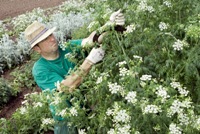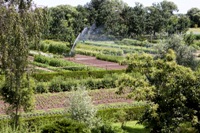Profile of a manufacturer
Treasures in the garden: Diversity, commitment and passion
by Dr. Wolfgang Kern
Head of Press and Publicity, DHU
Treasures in the garden: Diversity, commitment and passion
An example from DHU
It is 7 o’clock on a Sunday morning in July. Germany is still half asleep. But in the DHU medicinal plant garden in Staffort, at the foot of the Black Forest, they are already busy, watering the plants. The garden is twelve hectares, and it’s here that Germany’s largest manufacturer of homeopathic medicines grows over 500 species of medicinal plants. The plants thrive in organic conditions, completely without chemicals. Harvested plants arrive directly at the production plant of DHU in Karlsruhe, 10 km away, where they are processed, still fresh from harvest. DHU uses some 1,400 different substances for homeopathic medicines, and homeopathy lives and breathes by this diversity. Without this full range and the effort, commitment and passion for ensuring that diversity, homeopathy could not exist.
Homeopathy is more than a handful of pills
"Imitate it, but imitate it correctly," Samuel Hahnemann (1755 - 1873) told the users of his new therapeutic system. The basic concept is simple: ‘like cures like’. Its practical implementation, however, requires a major investment. First Hahnemann had to determine which substances trigger which symptoms, so that he could make use of this in reverse as homeopathic remedies for treating sick people. He tested thousands of different substances on healthy subjects and carefully documented the result as a ‘remedy picture’. For many years, he worked on the homeopathic repertories that now form the basis of homeopathic therapy.
Unlike conventional medicine, the selection of a homeopathic medicine is based on a variety of very different individual symptoms. The context of the symptoms also plays a major role in the remedy pictures – for example, whether external influences such as heat or cold make the symptoms better or worse. This approach is almost completely neglected in modern medicine today, which tends to offer standardised treatment for a defined indication, established with artificial parameters, for example primary hypertension, without finding the actual causes. In such cases, conventional medicine can offer effective preparations that are chosen with additional diagnoses (e.g. angina pectoris) and general guidelines. In homeopathy, however, the specific symptoms of the individual are determined, as well as the personal context of the whole person. The key for Hahnemann’s homeopathic treatment is therefore a wide choice of different substances. For example, Hahnemann listed 1,046 symptoms for the Pulsatilla remedy (Pasque Flower Meadow), that he had observed in the provings on himself. He counted at least 117 of these symptoms in others.
In practice, this means that manufacturers of homeopathic remedies face a number of significant differences from the traditional pharmaceutical industry. At DHU there are about 1,400 different starting materials, 800 of which come from medicinal plants, of which in turn 600 are fresh and 200 dried. The other 400 are minerals or animal substances. All raw materials have to be procured or grown to the required quality, in compliance with numerous regulations, for example for species protection and nature conservation. Of course, the company must also guarantee that it is using the right kinds of substance from the rich treasure of nature, in accordance with the German Homeopathic Pharmacopoeia (HAB) or the European Pharmacopoeia (Ph. Eur). Great expertise and appropriate processes are needed to correctly determine, for example, a dried root. DHU itself has one of the world's most competent departments in Pharmacognosy, the study of medicines derived from natural sources.
Another big difference with conventional medicine is the number of different medicinal products that result from the high number of substances and the large number of dosage forms. DHU has a portfolio of up to 400,000 different medicinal products. Some 14,000 of these, the most commonly used preparations, are held as stock. In addition, DHU makes over 70,000 individual products each year, guaranteeing patients and therapists the full range of products needed for the proper practice of homeopathy. The low cost of these preparations is not in direct proportion to the elaborate manufacturing. DHU holds a vast stock of pre-potencies and has an in-house pharmacy, so that it can serve individual needs within 2 to 3 days.
At the heart of the process is the medicinal plant garden, where DHU cultivates its own medicinal plants. One pharmacist who visited with his team spoke of ‘feeling the heartbeat of the forces of nature’. Peter Riedel, DHU head of Pharmacognosy and medicinal crops in Staffort explains it like this, "We are responsible for the medicines from their very beginning, from the actual seed through to the final pilule, and we are actively involved in each step, so we develop a special closeness to our medicines. There are 16 workers in the garden. A love of plants is a prerequisite, as they accompany the plants all year round through each phase of growth and development."
DHU is proud of its vast expertise and nearly 150 years of history. Dr Harald Orth is director of pharmacy. "For us it is very important that people also understand the specific nature of homeopathy and its complex background, and this is especially true of politicians who decide on the marketing approval processes in Europe,” he says. "Firstly, they need to know that the extensive number of homeopathic remedies is neither redundant nor a luxury. This is simply what is necessary to make available the full scope of homeopathy as developed by Hahnemann. This is our duty at DHU, and we are pleased to take on the challenge of managing these large numbers of different medicinal products. This begins with the often difficult task of obtaining the necessary starting materials in premium quality. And it ends with the fulfilment of new regulations for tens of thousands of preparations. Unfortunately we often experience that regulatory requirements are actually tailored to chemical preparations and are generally neither sensible nor financially viable when applied to homeopathic remedies," he explains. "We want people to understand how homeopathy is made and with this understanding, to adapt the regulation to this need. This is what is needed. The rest we are very happy to do.”



